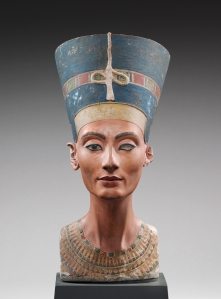 Her hat’s a bit dinged up, but she is undoubtedly beautiful, despite missing an eye. She is, or was, Nefertiti — and if her portrait bust is a true likeness, she outshines Elizabeth Taylor’s Cleopatra, the Mona Lisa, the Rococo chubbies of Rubens, Michelangelo’s metrosexually buff David, or the unknowable Helen of Troy. Nefertiti is not just beautiful, she is contemporary.
Her hat’s a bit dinged up, but she is undoubtedly beautiful, despite missing an eye. She is, or was, Nefertiti — and if her portrait bust is a true likeness, she outshines Elizabeth Taylor’s Cleopatra, the Mona Lisa, the Rococo chubbies of Rubens, Michelangelo’s metrosexually buff David, or the unknowable Helen of Troy. Nefertiti is not just beautiful, she is contemporary.
This is astounding considering her age. It is 100 years since she was dug up, but before that the Technicolor-bright painted plaster portrait bust languished for 3,500 years under the hot Egyptian sand.
Her Kate Moss stare, calm and dignified, is magazine-front-cover perfect, but this flawlessness is not some idealised, standardised image of beauty, airbrushed for the masses. No, this is a real person.
This is a portrait of someone, not anyone. If you were being overly critical, her nose is a bit large and prominent on her symmetrical face; her ears stick out; her forehead is a little too masculine and the dimples in her dimpled chin are just a little too far apart for perfection. But that’s the point.
The sitter for this bust, Nefertiti, was chief wife of heretic Egyptian pharaoh Akhenaten. In around 1350BC this husband and wife team set up a new capital city Amarna for a religion worshipping just one god, the sun god. This ill-fated flight into monotheism and the town of Amarna lasted just until Akhenaten’s son Tutankhamen switched back to the old religion and the old capital at Thebes.
Amarna disappeared under windblown sand. German archaeologist Ludwig Borchardt digging in Amarna in 1912 found Nefertiti stacked with other portrait busts in a storeroom of the studio of the court sculptor named Thutmose. In 1913 he controversially smuggled Nefertiti back to Germany. According to one story Borchardt hoodwinked the Egyptian authorities by daubing clay on the queen’s statue to disguise how uniquely beautiful she was.
Like so many countries whose antiquities were dug up by colonials, the Egyptians want their Nefertiti back from the Germans. And, like Greece and the Elgin Marbles, there is very little chance. Though Hitler toyed with the idea of giving back Nefertiti, she remains in Germany to this day. German museum authorities have always maintained from the first that the find was legally exported from Egypt, but it is a damning fact that, even as the rest of the Amarna finds were put on show from 1913, Borchardt demanded Nefertiti be kept secret. Suspiciously, it was not until 1924 that she was publicly unveiled.
The bust has one more secret. Revealed in a CT scan three years ago is an inner core limestone carving. It is not merely a rough mould for the highly individual portrait in stucco. No, it too is another unique representation of the queen, though tellingly some of the features differ.
Who is to say now whose decision it was to smooth out a bump in Nefertiti’s nose or remove creases in the corners of her mouth – all present on the limestone bust but missing in the final painted face? Perhaps it was the artist Thutmose; maybe it was a vain Nefertiti herself, or conceivably her doting husband. With a wife as beautiful as Nefertiti, my money’s on him.
